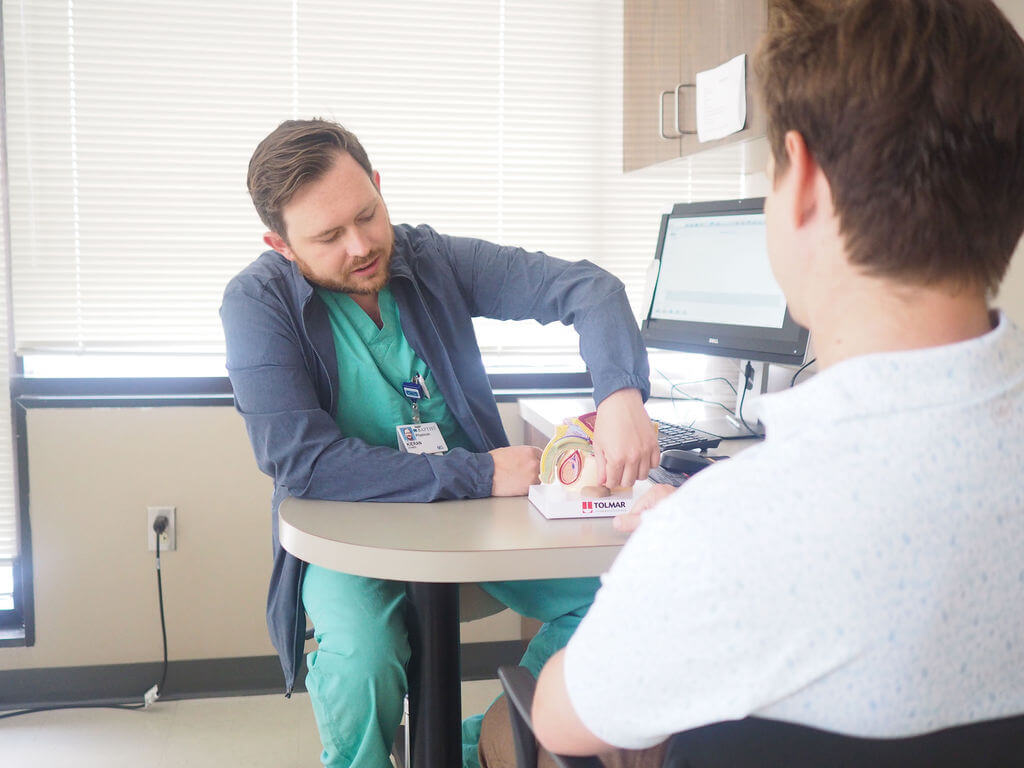While women are much more prone to urinary tract infections (UTIs) and other infections of the urinary tract and genitals, men can also get infections in the genital or urinary tract area. Not only can men get UTIs and kidney infections, but boys or men of any age can contract a testicle infection. Read on to learn more about epididymitis (testicle infection), what the risk factors are, and when to see a doctor.
What Is Epididymitis (Testicle Infection)?
The epididymis is a small, coiled tube located on the back of each testicle. This tube is actually 20 feet long but is coiled as such to allow space for sperm to mature. In addition to providing space for sperm to grow, it also adds moisture to the area and absorbs fluid to keep sperm healthy. It has three distinct sections, a head, a body, and a tail. Each epididymis is attached separately to each testicle, and if it becomes inflamed, this infection can spread to the testicles as well. The infection of the coiled tube itself is known as epididymitis; the infection of both the testicle and tube together is called epididymo-orchitis. The epididymis also attaches to the prostate gland and the urethra. Infection may enter via the urethra in retrograde (backward), which can infect the epididymis. Any type of epididymitis can be painful and cause swelling in the testicle and scrotum area.
Boys and men of any age can develop epididymitis; however, it is most commonly diagnosed in those ages 20 to 39. Epididymitis is caused by a bacterial infection, which can mature in the epididymis typically one of two ways: a bacterial infection following sexual contact, or bacteria from the intestines finding their way to the epididymis, commonly through the urethra. Epididymitis is not terribly common in children. Those who do develop the condition may have a bacterial infection as a result of abuse and should be thoroughly evaluated by a healthcare provider. It is important to know that infection and swelling of the testicles can exist without infection of the epididymis, and this is known as orchitis.
What Causes Epididymitis?
Bacteria is nearly always the underlying cause of epididymitis, which often enters via the urethra. The bacteria is usually identifiable, which can help your healthcare provider prescribe you the proper medication to clear the infection. Bacteria related to epididymitis are tied to sexually transmitted infections (STIs) and coliforms, the bacteria found in the intestines. In men younger than 39 who have a testicular infection, upwards of 80 percent of cases are caused by STIs. The two types associated with infection are Chlamydia trachomatis and Neisseria gonorrhoeae (chlamydia and gonorrhea, respectively). Chlamydia is responsible for roughly 60 percent of these cases. In men older than 39, the root cause is usually coliforms, with the most likely culprit being Escherichia coli (E. coli). It is also possible, but rare, for epididymitis to be caused by fungi or Mycobacterium spp.
Other possible, but infrequent, causes of epididymitis include the backflow of urine into the epididymis, which may be caused by having sex with too full of a bladder. This is referred to as chemical epididymitis. A heart medication known as amiodarone has also been connected to epididymitis cases. Viral infections such as mumps can also cause the condition, but this is a cause usually found in children where abuse is not a factor.
What Are the Symptoms of Epididymitis?
Symptoms of epididymitis are noticeable typically within 24 hours of contracting the infection. The first sign of inflammation begins in the vas deferens, which is a small duct that transports sperm to the urethra. From here, the inflammation will spread to the epididymis itself. Because of the direction in which the inflammation spreads, the first sign of epididymitis is often abdominal or flank pain. Following this descent, the testicles will begin to swell.
The next noticeable symptom is often scrotal pain or swelling, and patients may see the scrotum enlarge to four times its size as the bacterial infection spreads. Other noticeable symptoms of testicular infection include:
- Pain or burning during urination
- Discharge from the urethra (this symptom is connected to epididymitis caused by sexually transmitted diseases)
- Fever and chills
- Nausea and vomiting
- Blood in the semen or the urine
Symptoms of epididymo-orchitis or orchitis alone can be very similar. There will be noticeable pain and swelling in the testicular area.
Also, sometimes symptoms of UTIs or kidney infections may be similar to epididymitis. UTIs can also exist in the bladder, kidneys, and prostate. The most common symptom of UTI is burning and pain during urination. Patients would not likely see as much testicular inflammation with a type of UTI. It is essential to see your physician immediately if you have any symptoms of pain during urination or testicular swelling. Bacterial infections are easily treated but can be life-threatening if left alone.
How Is Epididymitis Diagnosed?
Your healthcare provider or urologist will first ask about your medical history and about your sexual activity. One of the easiest ways to detect epididymitis is to take a urine sample, as the bacteria are often found in the urine. In order to prescribe the correct treatment, the physician may try to grow more bacteria after extracting the culture to pinpoint what type of bacterial growth is related to the condition. Doctors will use different medications to eradicate various types of bacteria. First-line treatment is nearly always antibiotics, but there are many to choose from. The urologist may also take a swab from the urethra itself to rule out urethritis, which is a type of UTI that is an infection of the urethra itself. Other tests may also be ordered to confirm, such as a white blood cell (WBC) count, an ultrasound, CT scan, or MRI. Imaging studies may be ordered to rule out other causes of testicular swelling and pain, such as cancer, gangrene, or hernia.
What Is the Treatment for Epididymitis?
Often, the doctor will want to culture the bacteria to identify it, which may take up to a day or two. Many times physicians will prescribe multiple antibiotics because patients are infected with more than one bacterium. This may be a mixture of intravenous (IV) antibiotics, shots, and capsules or pills taken typically over a 10-day span. If sexually transmitted disease is the culprit, common medications include ceftriaxone and doxycycline. If bacteria like E. coli are the cause, ciprofloxacin and sulfamethoxazole and trimethoprim are often prescribed. It’s important to always finish a complete antibiotic regimen even after you’re feeling better to prevent the infection from returning.
How to Prevent Epididymitis
Risk factors for epididymitis caused by STIs include sex with a partner who is infected and sex without a condom. For epididymitis cases unrelated to STIs, risk factors can include an uncircumcised penis, a history of UTIs, an enlarged prostate, or prior use of a catheter in the urethra. Prevention in most cases mainly involves safer sex practices, such as a monogamous relationship and condom use every time you have sexual intercourse. Otherwise, it’s ideal always to keep the genital area clean and practice good hygiene, and make sure that you’re up to date on any mumps vaccinations. If you need more information on epididymitis or believe you may have testicular infection, request an appointment at Mississippi Urology Clinic today. We have nine different locations in order to provide convenience and quality of care.
















%20(1).png)










